Jim Potter's Blog, page 15
February 3, 2021
Sheriffs of Reno County: Steve Stapleton
 · Othar Wilson “Steve” Stapleton (1888-1963)Sheriff 1943-1947·
· Othar Wilson “Steve” Stapleton (1888-1963)Sheriff 1943-1947·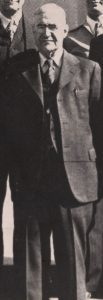 Reno County Sheriff “Steve” Stapleton. Author’s collection
Reno County Sheriff “Steve” Stapleton. Author’s collectionIt’s Saturday evening, November 14, 1942, in Hutchinson, Kansas. Brothers Stevie, 8, and Billy, 10, are playing hide-and-seek in the Reno County courthouse, First Avenue and Adams Street. Their father, Steve Stapleton, 54, a deputy and sheriff-elect, is taking his turn as relief for the regular jailer, Lloyd Gardner, who receives Saturday nights off beginning at 6 p.m.
*
“I’ll count to a hundred before I come looking for you,” said Billy to Stevie. “Remember dad’s rule, no going outside.”
Stevie hurried from the fourth floor jailer’s quarters, pushed the elevator button, then hurried down the marble staircase.
Billy stopped counting and thought about how his father had been elected the new Reno County sheriff and would take office in two months. At school, Billy’s classmates had already begun asking Billy to have his father visit their classroom. They wanted to know how he caught chicken thieves.
A chicken thief was nothing to laugh about. The criminals disrupted the family, especially the wife of a farmer who often counted on the sale of chickens and eggs for her spending money.
Once sheriff, Billy had been told by his father, his trips to pick up and deliver prisoners would increase, he’d inherit the first-floor office desk of Sheriff Ankerholz, and there would be less opportunities to stay overnight in the courthouse.
“Ring!” the elevator bell announced, making Billy aware he’d been deep in thought. He walked towards the staircase to find Stevie.
*
On the first floor, Stevie sipped a drink of water from the fountain while on tiptoes. Then he entered the inner ring—the wall of counters—where the employees stood during the day, facing outwards, as they served the public.
*
 Reno County Courthouse, Hutchinson, KS, at 1st Ave, & Adams Street during 1940s. Postcard by E. C. Kropp Co. Author’s collection
Reno County Courthouse, Hutchinson, KS, at 1st Ave, & Adams Street during 1940s. Postcard by E. C. Kropp Co. Author’s collectionQuietly, Billy walked down the staircase to the third floor and entered the lobby. Visually, he scanned the open space for Stevie then stared at the huge horizontal painting above the doors on the north wall. It was Coronado and his men encountering hostile tribes of plains Indians. There was also a priest who was trying to assure the red men.
Billy opened the door to the courtroom and immediately kneeled on the floor to see under the benches that resembled church pews. No Stevie. He stood up and walked to the stainless steel gate that opened into the official carpeted area where attorneys argued.
Again, Billy admired the historic art. Above the judge’s chair was a colorful mural displaying five people. Billy’s father had told him that the seated lady was the goddess of justice. The others included a woman pleading for mercy, a prisoner on his knees, a warrior with his sword, and a shackled prisoner awaiting punishment.
*
On the first floor, Billy said loudly, “I see you Stevie, you can come out now.”
Stevie was quiet. He didn’t move from his hiding place because he had been tricked before by his brother.
Billy walked over to the desk, kicked Stevie’s shoe, and said, “You’re it.”
As Stevie got to his feet, he asked, “What’s a prostitute?”
“I don’t know. Where did you hear it?”
“There are four women locked-up in one of the cells. When I asked dad what they had done to be put in jail, he didn’t answer. But later, I heard him talking to Mr. Winfrey about them being prostitutes.”
“Let’s find a dictionary,” said Billy. “I’ll look it up.”
Once the boys located a dictionary on a nearby desk, Billy found the word prostitute. He read the definition twice, but it didn’t make any sense to him.
“Should we ask Mr. Winfrey?” asked Stevie. “He’s always been nice to us.” Stevie looked down at his belt and touched the empty tobacco can that Mr. Winfrey had attached by making a belt loop. “He’s a trusty, doesn’t that mean he can be trusted?”
“Maybe,” answered Billy, “He’s nice, but he’s also a person who repeatedly writes worthless checks as soon as he’s released on parole. Dad says he doesn’t learn from his mistakes. Let’s wait and ask mom tomorrow when we get home.”
*
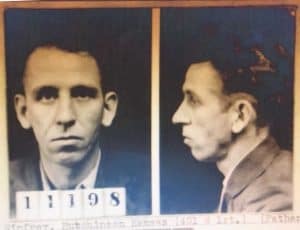 Ormel Thurston Winfrey
Ormel Thurston Winfrey1944 mugshot
“Congratulations on your landslide victory,” said trusty Ormel Winfrey, 32, to sheriff-elect Steve Stapleton, 54.
“Thanks,” said Stapleton.
“I hope you’ll continue to be supportive of us listening to the radio as long as it’s kept at a low volume and not disruptive,” said Winfrey.
“That’s up to the jailer, not me,” said Stapleton.
“Will you be keeping Mr. Gardner on as your turnkey?”
“We’ll see about that,” said Stapleton, noncommittal.
“Remember Turnkey Kelly?” asked Winfrey.
“Of course,” answered Stapleton.
“That man loved the smell and look of fresh paint,” said Winfrey. “I think slate-gray was his favorite color.”
“He used to be a painter,” said Stapleton. “He knew the importance of keeping this place neat and clean.”
“He had us washing our overalls twice a week and baths three times a week. Whenever there was a new prisoner, we could all hear Jailer Kelly declaring, ‘There’s not going to be any filth and dirt up here.’”
“Good for him,” said Stapleton.
“I remember when you were our full-time jailer,” recalled Winfrey. “You sure got our attention with those greeting cards you placed in each cell.”
“I meant every word of it,” replied Stapleton. Then he quoted the greeting by memory:
“‘My Friends, you and I are living under the same roof for a while. All of us make mistakes and at times do wrong. Perhaps you have. I know I have. My hope is that I will be a better man for having known you, and you will be none the worse for knowing me.’”
*
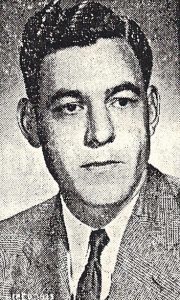 Eugene “Gene” Schroder, political ad in the Hutchinson News
Eugene “Gene” Schroder, political ad in the Hutchinson NewsDeputy Eugene Schroder unlocked the south door to the courthouse and entered. He heard the Stapleton boys before seeing them.
“Hello, Mr. Schroder!” yelled Stevie. “What are you doing here at night?”
“Stevie,” said Billy, “it’s none of your business.”
“It’s okay,” said Schroder, “I have a little tax-collecting work to do in the office, but I may do that later and go visit your father first.”
“Can we ride the elevator with you?” asked Stevie.
“Sure,” agreed Schroder as he pushed the service button. “Do you want to be locked inside the prisoner gate?”
“Yes!” answered both boys enthusiastically.
“First, let’s see how many of the bronze etchings you can identify,” said Schroder.
Billy pointed to one panel of the elevator door and said, “The bees stand for work or industry.”
“The owl means to be wise,” offered Stevie.
“The stair-steps that lead to the top of the pyramid mean strength or stability,” said Billy, “just like the steps in this courthouse.”
“That scale of justice shows equal weight or balance,” said Stevie. “It means justice.”
“You boys sure are smart,” said Gene as he watched the floor dial arrive from the fourth floor. As the elevator bell rang, and the doors opened, Gene looked at the boys and asked, “What are you going to be when you grow up?”
*
Until next time, happy writing and reading.

The post Sheriffs of Reno County: Steve Stapleton appeared first on Sandhenge Publications.
January 27, 2021
Sheriffs of Reno County: Guy Ankerholz
 https://jimpotterauthor.com/wp-content/uploads/2021/01/Sheriffs-of-Reno-County-22-Guy-Ankerholz.mp3· Guy Ankerholz (1904-1991)Sheriff 1939-1943·
https://jimpotterauthor.com/wp-content/uploads/2021/01/Sheriffs-of-Reno-County-22-Guy-Ankerholz.mp3· Guy Ankerholz (1904-1991)Sheriff 1939-1943·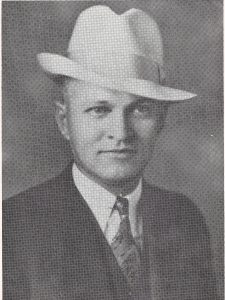 Reno County Sheriff Guy Ankerholz, 1939-1943
Reno County Sheriff Guy Ankerholz, 1939-1943It’s Monday, January 11, 1943, in Hutchinson, Kansas. Juanita, 32, and Guy Ankerholz, 38, are preparing to go to the Reno County Courthouse for the swearing in ceremony of the new sheriff, Steve Stapleton. Guy will be hanging up his star after having served nearly sixteen years: two terms as sheriff, after working for three sheriffs, Fay Brown, Ed Cunningham, and George Allison.
*
“Remember when we first met?” asked Juanita to Guy. “Pauline Gregg set me up for a date with Bill Sharp.”
“A double-date,” replied Guy. “It was January 1928, I was office clerk for Sheriff Fay Brown.
“We had a little problem,” reminded Juanita with a smirk. “Bill Sharp and I were in the convertible’s rumble-seat; you and Pauline were up front.”
“If my Whippet’s lights hadn’t malfunctioned, we wouldn’t have had an opportunity to talk so long while the garage man fixed it,” said Guy.
“You had a lot of nerve, kissing me on the cheek that night,” recalled Juanita.
“Guilty with extenuating circumstances,” said Guy. “It was love at first sight.”
“I remember what I said to my mother that night after you dropped me off, ‘Give me a pencil and paper! I need to write that guy’s name down. I can’t remember it!’”
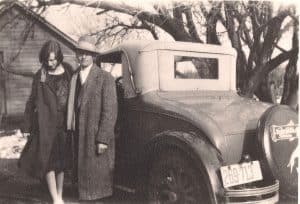 Juanita Chambers & Guy Ankerholz standing next to his 1927 Whippet convertible. Author’s collection
Juanita Chambers & Guy Ankerholz standing next to his 1927 Whippet convertible. Author’s collection“Do you recall your first driving lesson in the Whippet?” asked Guy.
“Bill Sharp was along, still in the rumble-seat,” answered Juanita with a smile.
“We were out by the Reformatory when you got behind the wheel,” recalled Guy. “You had both hands on the steering wheel and kept overcorrecting.”
I remember Bill’s words of encouragement,” said Juanita, “‘Hell, Juanita, keep it between the fence posts!’”
*
Six-year-old Guy began his formal education at Liberty School, District 130, one and-a-half mile from the Ankerholz home north of Sylvia.
When Guy started his third year of school, his life changed irreversibly. Guy remembered the period of time as a “misfortune.” He recalled how, in his family, the children always started the school year dressed in new clothes, including shoes and stockings. In those days the shoes had high tops with hooked islets for the shoe laces. Unfortunately, one of the islets turned up and scratched Guy’s shinbone above the right ankle.
After home remedies failed and the sore refused to heal, the doctor in Sylvia, Dr. W. H. Bauer, was visited. He diagnosed blood poisoning. The doctor lanced the abscess and as a result the infection entered the morrow of the bone.
Young Guy became very ill as he lay bedfast at home under the doctor’s care. As his health worsened, Guy’s father was advised to take him to Mayo Clinic in Rochester, Minnesota. After weighing the distance and expense, his parents followed the doctor’s recommendation.
Eight-year-old Guy and his parents boarded a train in Sylvia and arrived in Rochester two days later, about the middle of December 1912. The doctors discovered the poison had advanced up the right leg, crossed over to the left hip, and decayed a portion of Guy’s hip socket. In medical terminology it was “chronic osteomyelitis.” A bone building medication was given and the patient put in traction to separate the hip joint.
Finally, on February 9, 1913, Guy’s ninth birthday, the Ankerholzes started home. In spite of the expert care at Mayo’s, Guy’s hips fused together in a sitting position. It changed his life.
Guy missed a year of school. At first he walked with crutches and eventually learned to do without them. Guy’s permanent physical handicap meant a period of adjustment. He was disappointed at the opportunities lost, but focused on the ambitions for the future. As a child growing up, he was yet to discover the many things at which he could excel with his abilities.
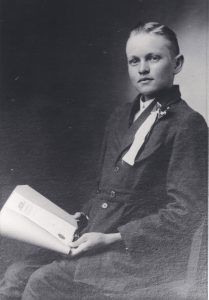 Diploma in hand, Guy graduates eighth grade from Liberty School, District 130. Author’s collection
Diploma in hand, Guy graduates eighth grade from Liberty School, District 130. Author’s collection*
“Being physically handicapped meant that education was vitally important to my future,” said Guy. “After graduating from Reno County High School in Nickerson, I enrolled at Hutchinson’s Salt City Business College, taking shorthand, typing, and banking classes.
“I looked for employment in Hutchinson but was unsuccessful,” said Guy. “One interview I had was at the First National Bank with the banker, Mr. Meyer. He told me: ‘I wouldn’t recommend it. If your dad owned the bank it would be all right. If your dad doesn’t own it, you can’t get any place in the business.’ I was glad to get the advice. It helped me decide to explore other directions.
“Without a job, I returned to my parents’ farm where I engaged in farming, but due to my disability, it was difficult. I wanted a job less physically demanding, but where was I to find one?
“After dark the evening of August 28, 1927, I returned from work at the Ford Agency in Sylvia and found a strange car sitting in the yard. My father was talking to three men. I was surprised when my father asked me what I had done to bring the sheriff to see him. After a few nervous moments, my father, a Republican, introduced me to Democrat Sheriff Fay Brown, and two other men in the car who were office holders in the court house.
“Mr. Brown asked me if I would be interested in working for him. ‘Doing what?’ I inquired, surprised. ‘Surely you wouldn’t want me to arrest anyone,’ I said. The sheriff replied that he wanted me as a clerk in his office. I said I’d love to and started within days.
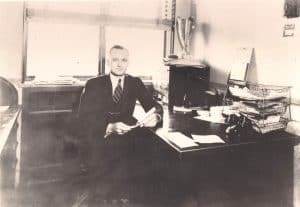 During the 1930s, Office Clerk Guy Ankerholz moved a lot of legal paperwork for the Reno County Sheriff’s Office. Author’s collection
During the 1930s, Office Clerk Guy Ankerholz moved a lot of legal paperwork for the Reno County Sheriff’s Office. Author’s collection“I knew absolutely nothing about the duties required of the clerk’s position. After being sworn in as a deputy, thereby receiving my deputy sheriff ‘commission,’ I sought out assistance from the ex-clerk and new tax collector, Jim Springer, who was my adviser and guide.
“I’d do anything for Fay Brown because he had the guts to hire me. That changed my life,” said Guy. “I was unlearned in my early days as a clerk. A couple of weeks after being hired, Sheriff Brown, referring to a gentleman leaving his inner office, told me, ‘Give this man a commission.’ I was at the front desk where I got the checkbook out and said, ‘How much?’
“I learned the job well,” continued Guy. “My immediate duties were preparing process papers and serving tax collecting papers. After a few months on the job, I accepted the additional responsibilities of county truant officer. More duties were assigned when I became responsible for state drivers’ licenses. Another part of my work as clerk and deputy sheriff was serving as an auctioneer. This meant selling property which had been foreclosed in the district court. In the early 1930s there were many foreclosures, land sales, and personal tax sales.”
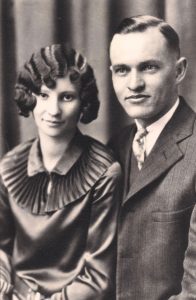 Newlyweds Juanita & Guy Ankerholz posed for this 1928 photograph taken at D&M Studio, 26 1/2 North Main, Hutchinson. Author’s collection
Newlyweds Juanita & Guy Ankerholz posed for this 1928 photograph taken at D&M Studio, 26 1/2 North Main, Hutchinson. Author’s collection“We were married during Sheriff Brown’s first two-year term,” said Juanita. “After nine months of dating, we exchanged vows at Newton’s courthouse on November 24, 1928.
“DeNean arrived September 1, 1932, while you were Deputy Office Clerk for Ed Cunningham. Donald Lee was born December 26, 1935, while you served George Allison.”
“The campaign was stressful when I ran for sheriff in 1938. It was a crowded field. George Salmon, Sheriff Allison’s undersheriff, was one of the seven Republican candidates.”
“Your re-election in 1940 was an overwhelming victory,” said Juanita. “You won all 56 precincts.”
“I was pleased to serve two terms,” said Guy. “It was a political path hard to imagine if I hadn’t been scratched from an islet and lanced with a needle.”
*
Guy Ankerholz became a public leader and servant. He proved to himself and to others that his disability could not prevent him from attaining high personal goals. With a warm smile for everyone and a shrewd political mind, Guy Ankerholz’s life was a lesson in courage.
*
Resource: “Guy Ankerholz: A Lesson in Courage,” by Jim Potter, Legacy: The Journal of the Reno County Historical Society, Volume 4/Number 2, Spring 1992
*
Until next time, happy writing and reading.

The post Sheriffs of Reno County: Guy Ankerholz appeared first on Sandhenge Publications.
January 20, 2021
Sheriffs of Reno County: George Allison
 https://jimpotterauthor.com/wp-content/uploads/2021/01/Sheriffs-of-Reno-County-21-George-Allison.mp3· George T. Allison (1883-1951)Sheriff 1935-1939·
https://jimpotterauthor.com/wp-content/uploads/2021/01/Sheriffs-of-Reno-County-21-George-Allison.mp3· George T. Allison (1883-1951)Sheriff 1935-1939·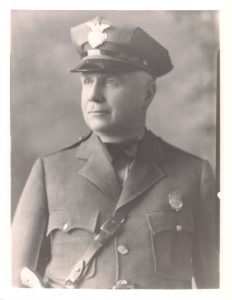 Reno County Sheriff George T. Allison. Author’s collection
Reno County Sheriff George T. Allison. Author’s collectionIt’s 1:30 Sunday afternoon, April 11, 1943, in Eureka, California, in St. Bernard’s Cathedral rectory. Georgiann Allison, 19, daughter of George and Charline Allison, Hutchinson, Kansas, is marrying Richard Harmon, 21, son of J. Clair and Florence Harmon, also from Hutchinson.
*
It’s Sunday afternoon, April 11, 1943, near Langdon, Kansas. Daisy May Sherow Jones folds and unfolds a newspaper clipping from the society page, then returns it to her family bible.
*
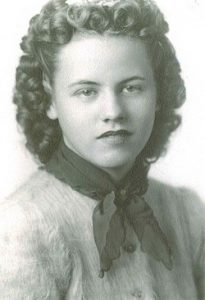 Georgiann Allison, Hutchinson High School 1940 yearbook senior class photo. Steve Harmon collection
Georgiann Allison, Hutchinson High School 1940 yearbook senior class photo. Steve Harmon collectionAs Georgiann dressed for her wedding day, she remembered a high school Homemaking class assignment from her senior year. Miss Marian Brookover, known as “Brookie,” was her teacher. The purpose of the class was to develop homemakers of tomorrow.
Well, Georgiann thought, tomorrow is today.
For the assignment, Georgiann had made drawings of her completely decorated future home. She even described her future husband and three children. Richard Harmon, who Georgiann was dating, was her first choice for matrimony.
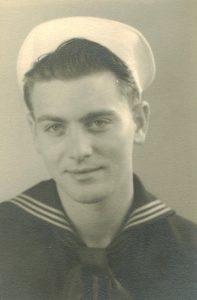 Donald “Richard” Harmon, SK 1/c, Coast Guard, yeoman and storekeeper. Steve Harmon collection
Donald “Richard” Harmon, SK 1/c, Coast Guard, yeoman and storekeeper. Steve Harmon collectionTwo years later, in July 1942, Richard enlisted in the U.S. Coast Guard, along with his buddy, Dave Betz. By the spring of 1943, storekeeper (SK) Harmon, and yeoman (YN) Betz, stationed at Samoa, north of Eureka, California, were missing their sweethearts in Hutchinson. They proposed a west coast wedding.
Click to learn about the “Sand Pounders”: US Coast Guard Beach Patrol
*
Charline Frances Graves was born and raised in Hutchinson, Kansas. In 1904, when George Allison came to town to help C. H. McBurney open his new dry goods store, Charline noticed.
George, 24, and Charline, 19, were married May 21, 1907, in a double-ring wedding in the home of her parents.
Charline closed her eyes and heard the piano music that had played during her marriage ceremony, Mendelssohn’s “Wedding March.”
She and George stood under an arbor of green foliage and ferns. Charline’s dress was white Swiss, beautifully trimmed in Mechlin lace. She carried bride’s roses.
*
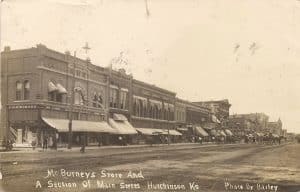 C. H. McBurney’s Dry Goods store in Hutchinson, Kansas. Photo by Marion W. Bailey. Author’s collection
C. H. McBurney’s Dry Goods store in Hutchinson, Kansas. Photo by Marion W. Bailey. Author’s collectionAs a boy in knee pants and barefoot, George started working for C. H. McBurney’s Dry Goods store in Burlingame, Kansas. Gradually, over the years, George learned the mercantile business. In 1904 he got an offer he couldn’t refuse. McBurney promised him steady work if he would move to Hutchinson with the owner-manager.
Charles McBurney opened “The New Dry Goods Store” in 1905. George Allison became the window trimmer and then the floor manager.
In April 1908, George got another offer. Hostutler & Hipple Clothing and Gents’ Furnishings, lured him away from McBurney’s. The timing couldn’t have been better. Charline gave birth to a baby boy the next month. They named him Burkson Willard.
*
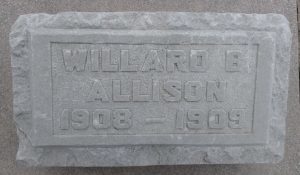 William Burkson Allison gravestone at Eastside Cemetery, Hutchinson, KS. Author’s collection
William Burkson Allison gravestone at Eastside Cemetery, Hutchinson, KS. Author’s collectionIn 1909, Charline and George were counting their blessings when tragedy struck. Burkson, fourteen months old, became ill and died after a short illness of spinal meningitis.
*
A small miracle occurred in 1923 when George was superintendent of the Hutchinson-Wiley Dry Goods Company. It had been fourteen years since their baby Burkson had died. Many people were surprised when George and Charline welcomed a homeless baby into their home.
In December 1923, the Allison’s introduced three-month-old Georgiann to their friends at a baby garment shower. Two months later, on February 8, 1924, they officially adopted her from the Kansas Children’s Home Society.
*
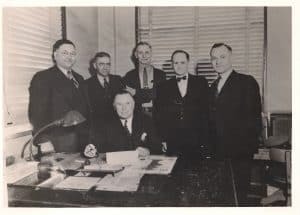 Reno County Sheriff George T. Allison (seated) with staff (L-R): George Salmon, undersheriff; O. W. “Steve” Stapleton, tax collector; Frank Kelly, criminal investigator; Oscar “Shorty” Shaw, jailer; Guy Ankerholz, office deputy. Author’s collection
Reno County Sheriff George T. Allison (seated) with staff (L-R): George Salmon, undersheriff; O. W. “Steve” Stapleton, tax collector; Frank Kelly, criminal investigator; Oscar “Shorty” Shaw, jailer; Guy Ankerholz, office deputy. Author’s collectionGeorge Allison took a four-year detour from the clothing business when he successfully ran for Reno County sheriff in 1934, and took office in 1935. He was reelected in 1936 and served until 1939. In his two terms as sheriff there were plenty of arrests yet no escapes from the county jail.
After an unsuccessful campaign running for Reno County commissioner, George opened up George Allison Cleaners.
*
The day of Georgiann’s wedding, she told her close friend, Velma Owen: “Sometimes, I wonder if my biological mother or father are still alive and if I have siblings. Can you imagine them ever thinking about me?”
“You may never know your birth parents,” said Velma. “Have you asked Charline or George for help?”
*
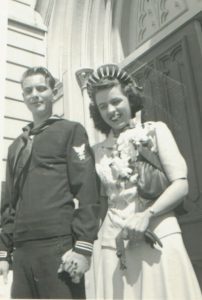 Wedding day, April 11, 1943, in Eureka, CA, for Richard Harmon & Georgiann Allison. Steve Harmon collection
Wedding day, April 11, 1943, in Eureka, CA, for Richard Harmon & Georgiann Allison. Steve Harmon collectionAs the Eureka, California, wedding ceremony ended, Georgiann shed a tear of happiness. She considered her life, about learning she’d been homeless as a baby, about being wanted and loved by new parents, about a future with Richard, including her expectations of raising three children. This was the life she had dreamed and the one she had planned in her high school Homemaking class. Georgiann still had the notebook to prove it.
*
It’s Sunday afternoon, April 11, 1943, near Langdon, Kansas. Daisy May Sherow Jones is shaking and crying. She picks up her bible and opens it. She unfolds a newspaper clipping.
As Daisy rereads the article about Georgiann Allison getting married in Eureka, California, Daisy’s grateful. She says: “Thank you god. My baby’s getting married today.”
*
Click to see a WANTED Poster: 1938 WANTED Poster
*
Until next time, happy writing and reading.

The post Sheriffs of Reno County: George Allison appeared first on Sandhenge Publications.
January 13, 2021
Sheriffs of Reno County: Ed Cunningham
 https://jimpotterauthor.com/wp-content/uploads/2021/01/Sheriffs-of-Reno-County-20-Ed-Cunningham.mp3· Ed Cunningham (1896-1971)Sheriff 1931-1935·
https://jimpotterauthor.com/wp-content/uploads/2021/01/Sheriffs-of-Reno-County-20-Ed-Cunningham.mp3· Ed Cunningham (1896-1971)Sheriff 1931-1935·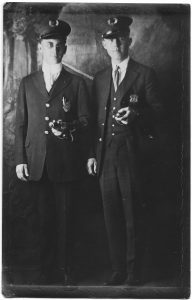 Hutchinson Police officers Fay Forrest Brown and Edward Russell Cunningham about 1921-1922. Photographer unknown. Author’s collection.
Hutchinson Police officers Fay Forrest Brown and Edward Russell Cunningham about 1921-1922. Photographer unknown. Author’s collection.It’s Wednesday, July 1, 1936, in Hutchinson, Kansas.
“Well, look what the cat drug in,” said Fay Brown, owner-operator of the Brown Wheel night club, as plain clothes city detective Ed Cunningham walked in the door.
Fay Brown and Ed Cunningham were old chums, lawmen, who had worked on the Hutchinson police force in the early 1920s and had teamed up as sheriff and under sheriff of the Reno County Sheriff’s office from 1927 to 1931.
*
“I needed to get outside, to feel rain on my face,” replied Ed, referring to the rain shower that had interrupted eight straight days of century temperatures.
“You’re early,” said Fay. “Our inaugural opening for this new location will be at 6 o’clock tomorrow night. But come on in and have a seat. Business or pleasure?”
“Brownie,” said Ed, as he remained standing, “it’s always a pleasure to see you.” Ed looked around the large space and nodded. “I thought it was time for me to see your new headquarters.”
Ed viewed the dance floor surrounded by booths and tables. He examined the bar with its neon lighting fixtures.
“We can seat 125 people, but I expect over twice that tomorrow night,” said Fay. “The crowd will dance to the Ray Close orchestra, and the Miss Dorothy Woods dancers will stage several floor shows.” Click to see advertisements for Dorothy Woods dancers: Dorothy Woods
“You’re forgiving,” said Ed. “I remember you objecting to Governor Reed granting a citizenship parole to Close because the felon had been convicted of a new crime, a car theft.”
“That was 1930, I think he’s changed,” replied Fay.
“Well, this clubhouse beats your old barn on the Sylvia pavement’s wet block.”
“Now that I own this property, I won’t have the clubhouse sold to build a chicken hatchery,” said Fay.
“By the way, we have reason to believe that Ray Waldo will wave his preliminary hearing on the larceny charge of stealing your overcoat from your cloak room,” updated Detective Cunningham. “If so, he’ll be bonded over to district court.”
“Thanks for the update,” said Fay. “How’s Esther doing?” he inquired.
“She’s well, thanks, and Cora?”
“Fine, she’s amazed at how quickly we’ve been able to purchase this property and construct the building. It’s 44 feet by 36 feet, the dance floor 25 by 18.”
*
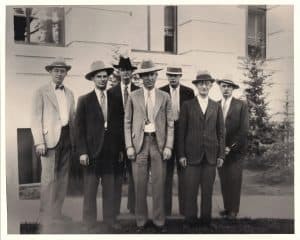 1931 or 1932 in front of the Reno County Courthouse, Hutchinson, KS. L-R: Cliff Kennedy, investigator; Bill Richardson, investigator; Martin E. Jolliffe, process server; Ed Cunningham, sheriff; Paul Cunningham, assistant investigator; Jim Springer, tax collector; Guy Ankerholz, office clerk. Author’s collection
1931 or 1932 in front of the Reno County Courthouse, Hutchinson, KS. L-R: Cliff Kennedy, investigator; Bill Richardson, investigator; Martin E. Jolliffe, process server; Ed Cunningham, sheriff; Paul Cunningham, assistant investigator; Jim Springer, tax collector; Guy Ankerholz, office clerk. Author’s collection“Remember when you were first hired on the police force?” asked Fay.
“I remember you taking me under your wing,” replied Ed. “Thanks again.”
“When the officers first heard that Ed Cunningham had been hired, they knew something was wrong,” remembered Fay as he laughed.
“Yeah, my name had preceded me,” Ed replied. “The colored Ed Cunningham liked to get drunk and hit women.”
“We’ve had some close calls,” said Fay. “Ed, you gave us all a scare the night you were shot in the face by Bowen the black bootlegger. When I heard about it, I was in shock. I kept repeating, ‘Not Ed, not Ed, dear god, not Ed.’”
“The prayers were appreciated,” said Ed. “Whether I want to or not, I remember it every day.” He raised both hands and massaged his temple. “You know about my headaches.”
“When the officer took Clint Bowen to Methodist Hospital to be identified by you,” said Fay, “I’ve got to admit, I thought the worst, that they wanted you to identify your assailant before you died, but you healed up pretty quickly once they removed the bullet from your neck.”
“I was too stubborn to die,” said Ed.
“Cora and Verna got closer because of that, so something good came of something bad,” recalled Fay. “Genevieve was just a one-year-old, wasn’t she?”
“Yes, she was still a baby,” agreed Ed. “Donald and Marvin followed in 1924 and ‘26.”
*
“How’s George Allison getting along with your boss?” asked Fay.
“All right, I think.”
“Do you know if he’ll go another term as sheriff?” Fay asked.
“Probably, he’s popular, but as you know, you never know with politics.”
“I think George’s job is harder than when we were sheriff because the people are more desperate,” said Ed. “Dust storms and drought destroy any hope for agricultural progress. This morning’s rain is welcome but it won’t be enough to stop the grasshoppers. More sodium arsenite is needed.”
“The Republicans need to give the New Deal a chance,” said Fay. “Governor Landon is out of touch and a poor choice for president.
“Ed, we’ve spent most of our years in law enforcement. We’ve been fortunate to not have to make a living off the land.”
“Farmers deserve a medal,” said Ed. “I couldn’t do it. They were losing money back in the twenties despite excellent crops, before the drought, before the Crash, and the increased ferocity of dust storms.
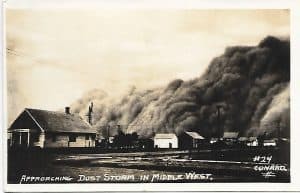 Frank D. “Pop” Conard (1884-1966), Garden City, KS, photographer, documented the destructive dust storms in Kansas during the ‘Dirty Thirties’. Authors collection
Frank D. “Pop” Conard (1884-1966), Garden City, KS, photographer, documented the destructive dust storms in Kansas during the ‘Dirty Thirties’. Authors collection“When the dust storms arrive, they continue to hurt my business,” said Fay. “It’s understandable. It’s inconvenient, even dangerous to go outside. It’s hard on cars and clothing, and it takes a toll on your eyes and breathing.”
“The other day the dust was so thick a prairie dog was seen burrowing ten feet in the air,” quipped Ed.
Looking just as serious, Fay asked, “Was that the same day the crows were flying backward to keep dust out of their eyes?”
“Recently, I stopped to assist a family on the side of the road,” said Ed. “They were from back East. The driver said the wind was blowing pretty hard. Like any good Kansan, I replied: ‘This ain’t nothing. Our farmers use log chains to gage the wind. When the chains stand straight out, you can figure the wind is picking up.’”
“The county commission keeps cutting,” said Ed. “I recall when the commissioners threatened to reduce our staff. I finally agreed to accept a 10% reduction in our salaries. I had no choice.
“When the state attorney general recommended law enforcement should be better equipped against bandits, the commissioners didn’t budge. ‘No,’ they said, they would not be purchasing machine guns, gas guns, or bullet proof glass for sheriff’s cars. Understandably, there were higher priorities.”
“Like sheriffs before us, the county allowed Cora and me comfortable living quarters at the sheriff’s residence when it was on Avenue B,” said Fay. “Ed, you were the last sheriff to live on the fourth floor of our new courthouse. Sheriffs will never be able to honeymoon in the suite like you and Dorothy did back in 1931.”
“Not anymore,” said Ed. “I know George has complained to the commissioners about the loss of the courthouse residence, but they say that the courthouse space is at a premium. Meanwhile, George and Charline are living at their regular home. In the long run, leaving the courthouse every day, instead of practically living in jail, may be a healthier choice for all future sheriffs.”
“You and I lived it 24 hours a day,” said Fay. “It was a call of duty, and through it all, we had a fulfilling job.”
“I’m still loving it,” said Ed. “As long as my health holds up, and the mayors don’t replace me, I’ll keep working for the city force.”
“We may not be farmers, helping feed our people,” said Fay, “but we have served the public, helping protect property and keeping the peace.”
“Yes,” agreed Ed, “I was born in Indiana and raised in Colorado, but Hutchinson, Kansas, is important to me. Unlike some others who have gone west, we’re not leaving. With fond memories, and friends, and family, we have faith in the future and we’re here to say, ‘It’s home.’”
*
Click to see “Reward” or “Wanted” postcards, including mug photos, of four criminals from 1932-1933: Harold Johnson 1932, Charles L Schott 1933, W E Johnson 1932, and Jack Weiter 1932.
*
Until next time, happy writing and reading.

The post Sheriffs of Reno County: Ed Cunningham appeared first on Sandhenge Publications.
January 6, 2021
Sheriffs of Reno County: Fay Brown
 · Fay Brown (1891-1968)
· Fay Brown (1891-1968)Sheriff 1927-1931
·
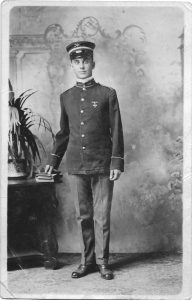 Fay Brown, Kansas National Guard, “E” Company, 2nd Kansas Infantry, with sharpshooter’s medal. Unknown date, between years 1912-1916. Author’s collection
Fay Brown, Kansas National Guard, “E” Company, 2nd Kansas Infantry, with sharpshooter’s medal. Unknown date, between years 1912-1916. Author’s collection

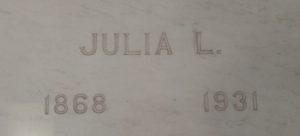 Julia Latimer Whiteside gravestone at Fairlawn Cemetery, Hutchinson, KS
Julia Latimer Whiteside gravestone at Fairlawn Cemetery, Hutchinson, KSIt’s Monday, August 3, 1931, in Hutchinson, Kansas.
“Buenos días mi amigo,” said Fay Brown, 40, causing Houston Latimer Whiteside, 41, to smile. It was Fay’s common greeting to those men who had served on the Mexican border in 1916 during the international trouble.
“We’re sorry for your deep personal loss,” continued Fay. “Julia was a gift to Hutchinson.”
“Thanks, Fay,” responded Houston, Jr. “If she hadn’t been visiting her sister here in 1888, she and Houston would have never met.”
“Her voice was angelic, her conversation engaging,” said Cora Brown, 37.
“The finest voice in the state,” added Fay. “And how’s your father?” he asked.
“Thanks Cora; thanks Brownie. It all happened so fast,” replied Houston, Jr. “It’s still sinking in for us that she’s gone. At every meal we expect to see her smiling face, hear her laugh, and words of wisdom. At least we were able to say goodbye. First on the train ride to Chicago, where Ada lives, and then the time together in Presbyterian Hospital.”
Junior continued, “Since father was 22 years older than her, he always thought he would die before Julia. He would even joke about her finding a younger man.”
*
“Do you think Houston, Jr. will ever get married?” asked Fay.
“Sure,” answered Cora. “If the right woman comes along at the right time. Houston, Sr. was 40 when he and Julia married, so it’s not too late.”
“On our New Year’s Day marriage in 1916, we were only 21 and 24,” remembered Fay.
“Fifteen years now,” said Cora. “I was a telephone operator at Missouri & Kansas Telephone Company and you were a merchant policeman. By July you were off to Eagle Pass on the Mexican border.”
“Those were a long four and a half months,” said Fay.
“Too long,” agreed Cora.
*
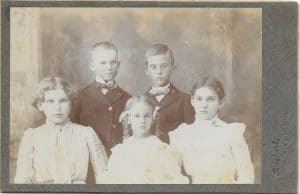 L-R: Dora Mae, Dallas E., Cloe Marcia, Fay Forrest, & Sallie Louise Brown, orphaned after the death of Elihu “Marcus” Brown (1857-1894) & Nancy “Orilla” Pressnal Brown (1861-1897), ca. 1899. Photographer: Charles L. Heichert, Newcastle, Indiana. Author’s collection
L-R: Dora Mae, Dallas E., Cloe Marcia, Fay Forrest, & Sallie Louise Brown, orphaned after the death of Elihu “Marcus” Brown (1857-1894) & Nancy “Orilla” Pressnal Brown (1861-1897), ca. 1899. Photographer: Charles L. Heichert, Newcastle, Indiana. Author’s collection“I’m glad Houston, Jr. and Ada got to have their mother for so many years,” said Fay.
“They’re probably not feeling lucky right now,” said Cora, “but yes, losing a loved one comes too soon.”
“I’ve tried, but I can’t remember my father,” said Fay. “I was only three when he died, but I recall my mother. When I was six she passed, and the five of us children became orphans in Henry County, Indiana.”
“When my mother ran off from our farm near Turon, it was hard on me and Occie,” said Cora, “but I learned a step-mother could also be hard. In the long run, it all worked out.”
*
“Losing Cloe to the 1918 influenza epidemic was tough,” said Fay. “Out of the five of us, she was the youngest. Cloe was only 25 when she, her husband, and their son died in Kansas City.” Click to read about Cloe’s death during The 1918 Influenza Epidemic
*
 Reno County Sheriff’s Office – 1927 Front L-R: Guy Ankerholz, office clerk; Fay Brown, sheriff; Cora Brown, matron. Back L-R: Martin Joliffe, process server; Ed Cunningham, undersheriff; Jim Springer, tax collector; Jess Blanpied, jailer. Author’s collection
Reno County Sheriff’s Office – 1927 Front L-R: Guy Ankerholz, office clerk; Fay Brown, sheriff; Cora Brown, matron. Back L-R: Martin Joliffe, process server; Ed Cunningham, undersheriff; Jim Springer, tax collector; Jess Blanpied, jailer. Author’s collectionYou’ve given a good part of your life to law enforcement,” said Cora, “including being president of the Kansas State Peace Officers Association the last two years you were in office.”
“I must have worked in every position or office on the police force and the sheriff’s office after my nights as a merchant policeman: motorcycle cop, patrolman, deputy, jailer, detective, chief of detectives, desk sergeant, chief of police, undersheriff, and sheriff.”
“Even today, you’re still arresting people,” said Cora.
“It’s different but the same,” replied Fay. “Jesse Deck and I can pretty much run our own show as detectives for the investigation bureau without political pressure.”
“I’m glad to be in our own home without the responsibility of preparing meals for a dozen or two boarders,” said Cora. “We had too many middle of the night calls from the public, and too many escaping prisoners. You still risk your life on every investigation.
“You’ve been hospitalized from fights and wrecks. Drunks have battered you on your head with your own gun. You were blinded by corn whiskey and fine glass particles when a woman bootlegger tried to destroy the evidence. Fortunately, you were able to undergo a successful operation on your right eye to regain your vision.”
Click to learn details about Fay losing his sight Blinded by Corn Whiskey
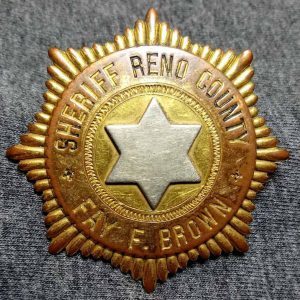 Fay F. Brown’s badge. He served two terms as Reno County (KS) sheriff, 1927-1931. Fay was a first cousin once removed of the author. (My paternal great-grandmother & Fay’s mother, were sisters.) Author’s collection
Fay F. Brown’s badge. He served two terms as Reno County (KS) sheriff, 1927-1931. Fay was a first cousin once removed of the author. (My paternal great-grandmother & Fay’s mother, were sisters.) Author’s collection“Mrs. Sheriff,” said Fay, we’ve been an exceptional team, especially during our four years at the sheriff’s residence. You gave up your telephone work to be matron and helped me on many a prisoner trip.
“The trips to pick up or deliver prisoners were a break from the jail routine,” said Cora. “They were sanity breaks.”
“I always tried to do right,” said Fay. “Enforcing the liquor law was the hardest part of the work, but I always tried to be fair, square, and honest with all.”
*
“One of my worst days as sheriff was July 19, 1927,” said Fay. “Having ten prisoners escape our jail in one night was embarrassing and created a lot of unnecessary trouble. Truman Reynolds, the ‘Bad Boy of Arlington,’ the ring-leader, was a pain in my side. Most of the other prisoners were short –timers, arrested for illegally riding the trains. I’ll never understand them tunneling out when they could have been free men in a few days.” Click to read Jail Escape by the Bad Boy of Arlington
*
Click to see Sheriff Fay F. Brown reelection advertisement
*
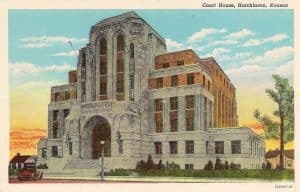 The new Reno County Courthouse at 1st Ave. & Adams Street, cost $500,000 to build. The new “escape proof” jail occupied the entire 5th floor. County prisoners were moved to the new jail on November 8, 1930. The first escape occurred one month later. Author’s collection
The new Reno County Courthouse at 1st Ave. & Adams Street, cost $500,000 to build. The new “escape proof” jail occupied the entire 5th floor. County prisoners were moved to the new jail on November 8, 1930. The first escape occurred one month later. Author’s collection“The new Reno County courthouse, First Avenue and Adams Street is a thing of beauty,” said Cora. “Ed Cunningham must be enjoying the jail and residence on the fifth floor.”
“He said he’s satisfied 100% and that it’s a wonderful building with everything convenient,” replied Fay.
“I’ll miss working closely with Ed,” continued Fay. “He’s been a chum since our early days on the Hutchinson police force. Some people were surprised that I’d have Republicans working for me, but he and I never let politics get in the way of our friendship or work.
“I wish Ed the best as he sheriffs for Reno County.”
*
Until next time, happy writing and reading.

The post Sheriffs of Reno County: Fay Brown appeared first on Sandhenge Publications.
December 30, 2020
Sheriffs of Reno County: Jesse Langford

https://jimpotterauthor.com/wp-content/uploads/2020/12/Sheriffs-of-Reno-County-18-Jesse-Langford.mp3
· Jesse Langford (1879-1935)
Sheriff 1923-1927
·
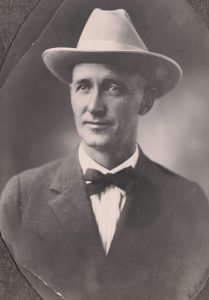 Jesse Langford. Photographer unknown. Author’s collection thanks to Laura Lee Langford Pearn (1985), daughter of Mary & Harvey Langford, granddaughter of May & Jesse Langford.
Jesse Langford. Photographer unknown. Author’s collection thanks to Laura Lee Langford Pearn (1985), daughter of Mary & Harvey Langford, granddaughter of May & Jesse Langford.It’s Wednesday, June 24, 1931, on the Atchison, Topeka, & Santa Fe Railway in route to Chicago, Illinois, from Hutchinson, Kansas. Houston, 81, and Julia Whiteside, 59, and their son, Houston, Jr., 41, are making an emergency trip to the windy city’s Presbyterian Hospital. Julia needs surgery.
*
“I do hope Wiley Post and his navigator succeed with their record flight around the world,” said Julia.
“They’ve completed the first lap of the flight and have been welcomed in Chester, England, and Hanover, Germany,” responded Houston.
“Look at Wiley Post now,” said Houston, Jr. “He wanted to become a pilot in the U.S. Army Air Service so he joined a training camp, but Germany surrendered before he completed his training.”
*
“Jesse Langford is a busy auctioneer,” said Julia, as she swayed to the moving railway car. “His outgoing personality fits the job.”
“He had a thriving business prior to being elected sheriff in 1922,” said Houston. “His win over Bill Clark, the incumbent, was competitive. For both terms of office, Jesse devoted his time to being sheriff, not auctioneering.”
“I remember Harvey, his son, being shot in the back after he and his uncle, Rolla Bridges, confronted an auto thief who had stolen Rolla’s Buick,” said Jr. “That was in 1921, before Jesse ran for sheriff.”
“Harvey could have died, that’s for sure,” said Houston. “He was only sixteen, still a student at Reno County High School. Being Jesse and May’s only child, if Harvey had died, they would have been devastated.”
“The bullet passed between his ribs, below the lung, barely grazing the liver,” said Julia. “It just missed his spine.”
Surprised at Julia’s memory, Houston and Jr. looked at one another with wide-open eyes and said nothing. Both father and son considered her medical prognosis and prayed for a successful surgery.
“The impetus for Jesse getting into the race for sheriff,” said Houston, “must have been that shooting, and the lack of severe prison sentences for the criminals. Up until then, he was content with his auction business and raising livestock.
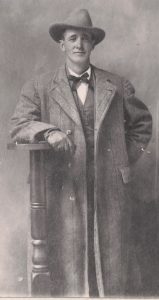 Jesse Langford. Photographer unknown. Author’s collection.
Jesse Langford. Photographer unknown. Author’s collection.“When the criminals were finally caught, they admitted to stealing the car but not to the shooting. Harvey and his uncle were trying to escape and didn’t see which man shot Harvey, so the case wasn’t solid. Actually, the county attorney was following the custom of the courts. Since attempt to kill was 1-10 years, and stealing a car, 5-15 years, the county attorney dropped the lesser charge.”
“Jesse always believed it was a miscarriage of justice. He said the crime was deliberate and cold-blooded; the offenders were thugs who belonged in the penitentiary, not the Reformatory.”
*
“If Officer Ed Cunningham had died in 1923, he would have never become our current sheriff,” said Julia. “Ed was shot during a police raid after a call had been received about a crap game and drunken brawl in progress. One of the bootlegger’s bullets struck Ed in his face and lodged in his neck.
“Ed was fortunate. He still has severe headaches, but he’s able to function and do his job.”
*
“In 1924, Sherman Monroe wasn’t as lucky as Harvey Langford or Ed Cunningham,” said Jr.
“When Sherman was again hired by the Hutchinson police force, he already knew from first-hand experience how desperate people can commit desperate acts,” said Houston, Sr. “Back in 1907, when Sherman was a guard at the Reformatory, he was nearly killed by two inmates who repeatedly hit him over the head with an iron pipe during their attempted break-away.”
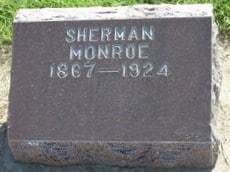 Gravestone of Reason Sherman Monroe, born June 11, 1867 in Tennessee; died July 3, 1924 in Hutchinson, KS. Eastside Cemetery, Hutchinson
Gravestone of Reason Sherman Monroe, born June 11, 1867 in Tennessee; died July 3, 1924 in Hutchinson, KS. Eastside Cemetery, Hutchinson“It was just before the July 4th holiday that Sherman met his maker,” said Julia. “He was 57. Maynor Cheek, 32, was holding his two-year old in one arm and a gun in the other when Officer Sherman approached. Cheek was outside the Brubaker grocery on Adams Street. Monroe might have avoided being shot had he opened fire at the assailant, but he was unable to return fire because of the danger of hitting the baby.”
“The family quarrel started when Cheek’s wife, Margaret Smith, 22, wouldn’t obey her husband,” continued Julia. “Maynor slapped her and drew a gun to try and keep her home. But she wasn’t intimidated. She called him a coward. Her neighbors called the police.”
Three of Cheek’s steel-jacketed bullets from his .25 calibre automatic, ripped into Officer Monroe. The Hutchinson officer’s wounds included one through the left lung, just above the heart, and two in his right arm.
In critical condition, sinking slowly, Monroe was able to maintain consciousness while at Grace Hospital, reporting details of the shooting. The following day, July 2, 1924, he died.
In Reno County, the hand of justice moved quickly. Cheek pled guilty to a charge of first-degree murder, was convicted, and sentenced to imprisonment for life in the state penitentiary. All this occurred prior to the victim’s funeral.
Cheek was taken to Lansing on July 5, 1924, just four days after the fatal shooting took place. Undersheriff Fay Brown accompanied the prisoner.
Brown recalled talking to Cheek at the county jail and on their trip to Lansing. Cheek told him that he never intended to shoot Monroe, that the only thing he remembered was the officer coming up to him and asking, “What’s the trouble?”
In 1907, Angie Rachel Davison Monroe, Sherman’s wife, had helped her husband recover after he was brutally attacked by reformatory inmates. But in 1924 there was nothing she or the doctors could do to save his life.
*
“I know Sheriff Langford arrested a lot of bootleggers,” said Houston, “but there was one case that stands out to me. No one was shot and no one died. It was when Walter Grundy, president of the Fourth State Bank disappeared from town. It was soon learned that due to his unsuccessful speculative activities on the stock market, he had embezzled money from the bank.”
Click for more information on Walter Grundy, bank embezzler: Walter Grundy Bank Robber
*
“When Walter Grundy, a trusted banker, embezzled money it was unexpected,” said Houston, “but what about the Arlington bank robbery in 1927 just a week before Langford left office? No one from Greensburg could believe Delos “Jack” DeTar, a respected businessman, would do such a thing.
“Eventually, he pled guilty to the crime and did his time in the penitentiary.”
Click for more information on Delos “Jack” DeTar, bank robber: Arlington Bank Robbery rabbit hole
*
 Front: Jesse E. and May Burkhalter Langford with their son, Harvey Horace. Photo 1928. Author’s collection
Front: Jesse E. and May Burkhalter Langford with their son, Harvey Horace. Photo 1928. Author’s collection“Jesse and May Langford were happy to get back on the farm after four years in jail,” said Julia. “I’ll bet May and Jesse slept for a week after four years of working night and day for the county.”
“In no time, Jesse was auctioneering again,” said Houston, Sr., “but in April he testified at the DeTar trial.”
“Harvey graduated from the University of Kansas,” said Julia. “So did Mary Louise Morgan of Kansas city. They married in 1929 and are living in Alamosa, Colorado, where he is a salesman for Joh Deere Plow Company.”
“Have you ever considered how a split second in your life might make a difference between life and death?” continued Julia. “You might say, that when Harvey was sixteen, he dodged a bullet.”
*
Until next time, happy writing and reading.

The post Sheriffs of Reno County: Jesse Langford appeared first on Sandhenge Publications.
December 23, 2020
Sheriffs of Reno County: William “Bill” Clark

https://jimpotterauthor.com/wp-content/uploads/2020/12/Sheriffs-of-Reno-County-17-Bill-Clark.mp3
· William “Bill” Clark (1864-1934)
Sheriff 1921-1923
·
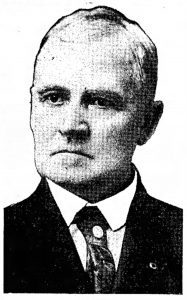 William Thomas Clark, Hutchinson News, February 12, 1934
William Thomas Clark, Hutchinson News, February 12, 1934*
It’s Monday, October 24, 1927, in Hutchinson, Kansas. Houston Whiteside, 81, tells Julia, his wife, 59, that the escapees from the Reformatory released their kidnap victim, Roy Lloyd, unharmed, in Kansas City, Missouri, on Saturday afternoon.
“Mr. Lloyd is home safe. He was released after the men on the run decided not to ‘bump him off,’” said Houston. “The police haven’t located the criminals yet.”
*
“Bill Clark must have an interesting job as justice of the peace, said Julia. “One minute he’s deciding a criminal case from the bench and the next moment he’s officiating a wedding.”
“I wonder if he’s ever done both in the same day for the same person?” commented Houston.
“I recall hearing about a wedding in the county jail when a prisoner and his girlfriend got married so that she could make regular visits,” recalled Julia.
“That reminds me of when Bill was sheriff and there was a bigamist being held at the bastille,” said Houston.
“Oh, do you mean Louis Tucker?” asked Julia. “He was the one who had two wives visiting him and each women was trying to get him to choose her as the one he loved most.”
“That’s his name,” agreed Houston. “I recall how Mr. and Mrs. Sheriff, Bill and Eva Clark, tired quickly of the drama. I can see how the sheriff was faced with a dilemma. Only attorneys, ministers, and relatives had visiting privileges. Which wife was the legitimate one?”
“As you know, Judge, normally it would be the first wife,” answered Julia. “You’d think living a secret life like that—two marriages at once—would be more than one man could handle.”
“Eva finally told Tucker to choose one,” remembered Houston. “Until the bigamist decided, Bill wouldn’t allow either of the women to visit. Do you recall which wife won his affection?”
“In the short run, it was wife number two, Maggie, the newlywed with the strong accent. She was a Boer, born in South Africa,” answered Julia. “When Bessie saw that she had been replaced by the newer model, she settled for $25 monthly alimony and $50 in attorney fees.
“But Maggie had no easy time of it,” continued Julia. “After waiting three months for his release, the Wichita authorities arrested Tucker when he completed his Reno County jail sentence. His new charge was making a false affidavit to a marriage certificate.
“Maggie’s anxiety increased. She said she was done with Tucker and attempted suicide by using chloroform.
“Bessie, the woman who had been replaced by Maggie, divorced Tucker, and soon married again. However, the legal marriage was not the road to eternal bliss.
“About three months after the wedding bells, Bessie’s new husband charged her with abandoning him.”
“What had she done?” asked Julia before answering her own question. “Bessie had traveled to Oklahoma City to live with the irresistible Louis Tucker. As far as I know, at the time he was single, not married.”
Click to view a reward postcard for a bigamist Wanted for Bigamy 1921
*
As sheriff, Bill Clark learned that catching criminals was only half the battle,” said Houston. “Keeping them locked up, preventing their escape, was a full-time job. He convinced the county commissioners that hiring a night jailer and installing chilled steel bars were necessary steps to maintain jail security, and that those improvements would cost less than the money spent on catching and returning escapees.”
“Every sheriff has spent a good bit of his time on long train rides, picking up and delivering prisoners,” said Julia.
“After the windows of the jail had their iron bars replaced with the steel bars,” said Houston, “the prisoners shifted their attempts at escape to tunneling their way out through the old plaster and stone walls.”
“Ah, yes,” said Julia, “idle time sparks creative minds.”
*
Prisoners held in the Reno County Jail were charged with a wide range of crimes, including theft and violation of the prohibitory law.
Sheriff Clark, a career insurance agent, said the theft of motor cars were either stolen by professionals, “floaters” (transients), or by people the owners hired in order to collect the insurance. Click to view a wanted postcard for a stolen car Stolen 1919 Dodge Touring Car postcard
Clark also understood how fingerprinting could become an extremely valuable tool both civilly and criminally if it was required on a national scale.
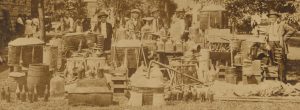 Confiscated stills and bottled liquor from Reno County Sheriff’s Office raid in 1921. Far right: Sheriff W. T. Clark
Confiscated stills and bottled liquor from Reno County Sheriff’s Office raid in 1921. Far right: Sheriff W. T. ClarkThe ratification of the 18th Amendment to the Constitution of the United States in 1919 didn’t have an immediate effect in Kansas. The state had prohibited the manufacture and sale of “intoxicating liquors” since 1881, and in 1917 the legislature had passed the so-called “bone dry” bill where it became unlawful for anyone “to keep or have in his possession, for personal use or otherwise,” any intoxicating liquors.
*
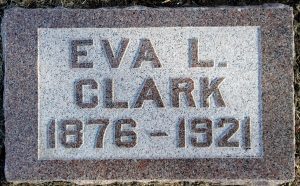 Gravestone of Rose “Eva” Hopper Clark, 2nd wife of W. T. Clark. His first wife, Lida Amelia Herman Clark, died in 1899. Eastside Cemetery, Hutchinson, KS.
Gravestone of Rose “Eva” Hopper Clark, 2nd wife of W. T. Clark. His first wife, Lida Amelia Herman Clark, died in 1899. Eastside Cemetery, Hutchinson, KS.“When Sheriff Clark lost his bid for reelection to Jesse Langford in the fall of 1922, he didn’t cry about it, did he?” Julia reminded Houston.
“He sure surprised everyone,” agreed Houston. “After Eva died of cancer in 1921, the sheriff’s residence was a quieter place—if you don’t count the prisoners making a racket in the attached jail. But, to his credit, Bill continued doing his duty.
“On November 7th, 1922, Clark lost the election, but he was smiling the next day, his 58th birthday, when he eloped with Minnie Calvin Bennett, 49, the jail matron. They motored to Newton in the afternoon and returned as Mr. and Mrs. W. T. Clark.”
*
“Bill has been in the insurance business for a long time,” said Julia.
“He was selling life insurance in 1905 at the time of his tragic accident,” she recalled. “When he was getting off the Missouri Pacific passenger train, while it was moving, he slipped, and his left foot was crushed under the wheels of the cars. It was necessary to have it amputated just above the ankle.”
“Bill never let his injury hold him back,” said Houston. “He was desk sergeant for the Hutchinson police force, undersheriff for Sheriff Scott Sprout, Reno County sheriff, and the first president of the Kansas State Peace Officers’ Association.”
“And Bill Clark continues to sponsor and promote the annual charity concert he started,” said Julia. “I think this year will be the 14th in a row at Convention Hall.”
“It’s a worthy cause,” agreed Houston. “The milk fund benefit concert helps furnish milk to poor and undernourished children in the city’s schools during the winter.”
“Eventually, William Thomas Clark may be remembered better for his charity concerts helping children, than being identified as a former sheriff or justice of the peace,” said Julia.
“Yes, said Houston. “You never know what you’ll be remembered for, do you? You just hope it’s for doing your best and making a difference.”
*
Until next time, happy writing and reading.

The post Sheriffs of Reno County: William “Bill” Clark appeared first on Sandhenge Publications.
December 16, 2020
Sheriffs of Reno County: Walter “Scott” Sprout

https://jimpotterauthor.com/wp-content/uploads/2020/12/Sheriffs-of-Reno-County-16-Scott-Sprout.mp3
· Walter “Scott” Sprout (1875-1941)
Sheriff 1916-1921
·
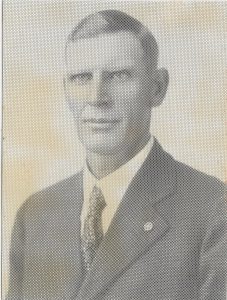 Reno County Sheriff Scott Sprout
Reno County Sheriff Scott SproutIt’s Saturday, October 22, 1927, in Hutchinson, Kansas. Julia, 59, and Houston Whiteside, 81, are discussing the escape of three men from the Reformatory.
“The inmates were members of a work detail digging sweet potatoes when they overpowered a guard and took his .38 calibre Colt revolver,” said Houston. “They kidnapped a man on Harvey Street while he was collecting the family laundry and forced him to drive them to Kansas City in his Ford motor car.”
“Did the man escape from the escapees?” asked Julia.
*
“I remember hearing about the declaration of war,” said Julia. “It was a Friday afternoon, April 6, 1917, after the Loyalty Day parade. We wound up at Convention Hall. The municipal auditorium was jammed to the doors with the great audience.”
“Yes,” agreed Houston, “Lieutenant Governor W. Y. Morgan stepped to the front of the stage and announced the breaking news. There was a hush and then a great cheer burst forth.”
*
 Artist James Montgomery Flagg (1877-1960) designed 46 posters for the US government. ©1917 Leslie-Judge Co., NY. Library of Congress
Artist James Montgomery Flagg (1877-1960) designed 46 posters for the US government. ©1917 Leslie-Judge Co., NY. Library of Congress“Woodrow Wilson was our war-time president,” said Julia, “but Scott Sprout was more than a sheriff. He wore another hat. He was the chairman of the Reno County Draft Board. Some people were upset when a son or a husband was drafted, but Sprout had a good reputation for being fair and square.”
“Scott didn’t know the hardships of war from personally serving in the military, but he knew one special person who had made a sacrifice,” said Houston. “His father. Francis was in the Missouri Volunteer Infantry when his Union service ended at the Battle of Shiloh. He lost his right arm on the battlefield after the hand was shattered.
“Sometimes, Sprout got blamed for doing his job,” continued Houston. “The local board examined the forms and the attached affidavits from men requesting an exemption. Not every farmer’s son was vital to the war effort. Not every married man was needed to care for a family, especially when his wife was young and employable and there were no children.”
“Our Houston wanted to train to be an aviator after graduating at West Point,” said Julia, “but instead, I’m glad he was able to train men stateside during the war.”
*
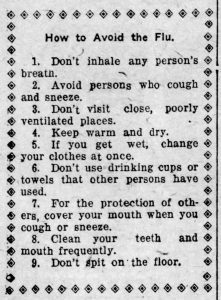 Hutchinson News, October 8, 1919
Hutchinson News, October 8, 1919It’s still difficult to imagine how the Great War was fought during a world flu epidemic,” said Julia.
“In our Civil War, approximately two-thirds of the military deaths were from disease, mostly diarrhea and dysentery,” said Houston. “In the Great War, over half of our personnel were lost to disease, largely due to the influenza epidemic of 1918.”
“It was a scary time,” recalled Julia. “While our men and women serving ‘Over There’ were risking their lives in a war, they were concerned about loved ones back here becoming sick from the influenza.”
“Think about it,” said Houston, “all the men living so closely together in the training camps, packed together on trains, then in ships to and from Europe; the conditions were ideal for the disease to spread.”
*
I heard that Clarence Sprout got married last month,” said Julia. “He was sure in the spotlight while he lived with his parents at the jail.”
“The Sprout family—Scott as sheriff, Carrie as matron, and Clarence as deputy sheriff—adapted well to the big city life of Hutchinson,” said Julia. “It was a different world than Turon and farming in Miami Township.”
“At six-feet, three-inches tall, Clarence excelled at sports,” said Houston, “especially football and basketball. But many people from Reno County remember Clarence, at age 17, being appointed as the youngest probation officer in the state, possibly the nation.”
“Judge Charles Fulton had a lot of trust in that boy,” agreed Julia. “They became close personal friends after the Sprouts moved to Hutchinson in order for Scott to take office as sheriff and Carrie as matron. The judge saw a young man who was absolutely devoid of all vicious habits, and in addition, possessed remarkable intelligence and good judgement.”
“Clarence refused the offer at first,” said Houston, “but Judge Fulton could be persuasive.”
“Remember the star that Judge Fulton presented to Clarence?” asked Julia. “He wore it proudly.”
*
“If Sheriff Sprout had a thorn in his side, it was from one too many prisoners escaping from his bastille,” said Houston. “Of course, it’s still a problem today. Just ask Sheriff Fay Brown.”
“Sheriffs have always considered running around the country, retrieving escapees, a nuisance,” said Julia, “but it comes with the territory, and it can get expensive.”
“Until W. T. Clark became sheriff, the county commissioners were reluctant to replace the easily sawed soft iron bars with expensive chilled steel bars,” said Houston.
“I remember Carrie Sprout overhearing an escape plot when she was matron,” recalled Julia.
“Carrie was busy supervising the feeding in the jail, and campaigning for a detention home so that unfortunate girls and women would not need to be sent to the state detention farm at Lansing. Click to view Carrie’s deputy sheriff appointment form: Carrie Sprout appointment as deputy sheriff
*
“Armistice Day was a time for thanks,” said Julia.
“The Great War was finally over,” echoed Houston.
“Our Houston was safe,” said Julia.
“We were fortunate,” agreed Houston. “We sacrificed very little. There was no gold star displayed at our door. We couldn’t travel as much, but we remained healthy and well off. Despite the war, our crazy and colorful parties continued.”
“But remember,” said Julia, “even as people celebrated, the newspapers continued to publish the casualty lists of soldiers who had been killed in action or had succumbed to their injuries.
“The United States had fought a war to make the world safe for democracy, and as survivors—military and civilian—we wanted to go back to a time that was normal.
“At the Armistice, the schools were beginning to reopen after a three week enforced vacation due to the Spanish influenza,” Julia remembered.
“For some reason,” said Houston, grinning, “there’s one specific, minor event that made me think we might be able to regain a bit of our former life. It was when I heard that the Haven High School boys were ready to begin their football season since they were done herding all the cows off their football field.”
*
Until next time, happy writing and reading.

The post Sheriffs of Reno County: Walter “Scott” Sprout appeared first on Sandhenge Publications.
December 9, 2020
Sheriffs of Reno County: Tom McGinn

https://jimpotterauthor.com/wp-content/uploads/2020/12/Sheriffs-of-Reno-County-15-Tom-McGinn.mp3
· Tom McGinn (1883-1956)
Sheriff, December 31, 1916 – January 4, 1917
·
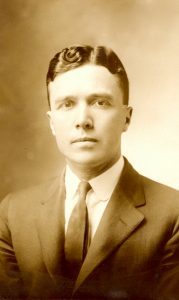 Tom McGinn. All photographs compliments of Frank Niemeir, unless identified otherwise.
Tom McGinn. All photographs compliments of Frank Niemeir, unless identified otherwise.  Ethel Rose Sames McGinn. Photographer: Electric Studios, El Dorado, Kansas.
Ethel Rose Sames McGinn. Photographer: Electric Studios, El Dorado, Kansas.It’s Saturday, October 22, 1927, in Hutchinson, Kansas. Julia, 59, and Houston Whiteside, 81, are sitting at their dining room table when Julia stops talking, turns her head to the southeast, and announces, “The reformatory siren is going off.”
“I wonder who escaped,” said Houston.
*
“Which Reno County sheriff was never elected, but he served in that position for four days?” asked Julia.
“As a retired attorney,” said Houston, “I suppose Under Sheriff Tom McGinn became the official sheriff for the period of time between the death of Tom Jennings and the day Governor Capper appointed Scott Sprout the new sheriff, whether there was a swearing-in ceremony or not.
“I believe the statute stated that in the absence of the sheriff the under sheriff shall carry out the duties of the office,” Houston continued.
“It may not matter to anyone else,” said Julia, “but it might matter to Tom McGinn. Being sheriff was an ambition he held for many years, but obviously, he didn’t want it due to Tom’s death.”
“Earlier, we were talking about Deputy Don Jennings not being appointed sheriff when the governor chose Republican Scott Sprout to replace Tom Jennings after his fatal car crash,” said Houston.
“Yes,” said Julia, “politics.”
“In my mind,” said Houston, “there’s no question that Tom McGinn, an experienced lawman, was better prepared than Deputy Don Jennings or farmer Scott Sprout.”
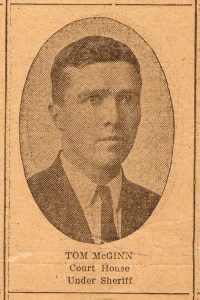 Reno County Under Sheriff Tom McGinn, 1911-1916
Reno County Under Sheriff Tom McGinn, 1911-1916“Tom had been under sheriff for two terms with Koon Beck and one term for Tom Jennings,” said Julia. “He was ready.”
“At least Sprout had worked towards becoming sheriff while he was on the campaign trail,” said Houston. “I thought it was magnanimous of Sprout to offer Tom McGinn and Don Jennings positions in his new administration.”
“Neither one of them could accept his offer,” said Julia. “Within a few days of the governor’s appointment, they were both hired by the Hutchinson police force.
“I remember how generous Tom McGinn was to the Jennings family after Tom’s fatal car wreck,” continued Julia. “Even though he was ambitious to be promoted, he offered to be Don’s under sheriff if the governor appointed Don as the new sheriff.”
“That act of generosity to the Jennings family proved to me that McGinn had the integrity to be anyone’s boss,” concluded Houston.
“Maybe someday he’ll be a chief or a sheriff,” said Julia. “He’s continued his law enforcement career, first by solving crimes on the Hutchinson police force, and then in Butler County at El Dorado and Oil City.
*
“Tom and Ethel McGinn have also shown their generosity and character by raising Dorothy Sames, their niece, as though she was their own child,” said Julia. “She must be 15 years old now.”
“I wonder if Dorothy is musically inclined like the rest of the Sames family,” continued Julia.
“The Sames ladies play the piano and sing, but not as well as you, dear,” said Houston.
*
The talented Sames family had gathered two months earlier for a family celebration at the Charles and Effie Chandler home in Hutchinson, Kansas.
*
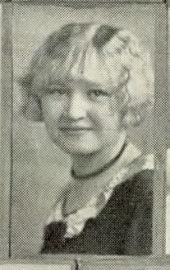 Dorothy Sames in the El Dorado High School yearbook, El Doradoan, covering school year 1927-28.
Dorothy Sames in the El Dorado High School yearbook, El Doradoan, covering school year 1927-28.“Are you sure Clara will be at the family reunion today?” asked Dorothy, 15, of her aunt and uncle, Ethel and Tom McGinn, who were raising her.
“Of course she’ll be there,” answered Ethel, “it’s at her house. You two can sit together, but remember the party is in honor of my sister, Mattie. It’s her 40th birthday. She won’t be here very long before returning to LA.”
As Tom drove the car, he recalled his youth as an only child. After his father’s death, it was just he and his mother, Emma, a family of two.
Over the years, since Thomas and Ethel Rose were married in 1911, they had attended a good many family functions. Ethel was one of seven children. Tom always enjoyed any get together, especially if Effie Kate Sames Chandler, Ethel’s twin, was there. Tom liked to observe the two of them as they aged.
Tom remembered 1912. That year, the twins, age 27, were each expecting a baby. Effie and her husband, Charles Chandler, named their baby girl, Clara Belle.
Unfortunately, the Christmas baby Ethel and Tom expected, was born and died the same day.
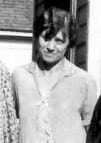 Mattie Gertrude Sames Bixler, 1927
Mattie Gertrude Sames Bixler, 1927Mattie Gertrude Sames, the youngest sibling of Ethel and Effie, also gave birth in 1912. Mattie and husband, John Bixler, Sr., welcomed Helen Margaret (their fourth of seven surviving children).
Ethel, Effie, and Mattie, had one brother, William Frances Sames. He and his wife, Addie Bell, also had a child in 1912. They named her Dorothy.
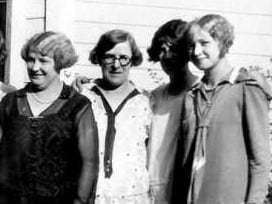 L-R: Ethel Rose Sames McGinn, Effie Kate Sames Chandler, Clara Belle Chandler, & Dorothy B. Sames, at family celebration, August 10, 1927. Frank Niemeir Photograph Collection
L-R: Ethel Rose Sames McGinn, Effie Kate Sames Chandler, Clara Belle Chandler, & Dorothy B. Sames, at family celebration, August 10, 1927. Frank Niemeir Photograph CollectionIt was Dorothy, niece of Tom and Ethel, who was welcomed into their home after the absence of her parents. William’s death in 1920, after a lingering illness due to the flu epidemic, started the collapse. Ultimately, Dorothy left Shawnee, Oklahoma, for a new, supportive family in El Dorado, Kansas.
*
“Will Uncle John and Uncle Thurman be there?” asked Dorothy.
“We’ll see,” said Ethel.
“The photograph we have at home with the airplane, is that of Uncle John or Uncle TJ?” asked Dorothy. Click to see photo: T. J. Bixler with airplane in 1904
“That’s TJ,” answered Ethel, “but both of them were aviators and assembled their plane together. John studied with the Wright brothers in Dayton, Ohio, and holds an international pilot license from the Aero Club of America.”
“My favorite photograph of them is the one with the four boys in their band uniforms,” said Dorothy.” Click to see photo: Bixler Boys Band
“Yes, that’s my favorite too,” answered Ethel. “They were cute boys, but so was Tom, when he was younger.”
“What do you mean when I was younger?” asked Tom of Ethel, as he opened his mouth in an exaggerated expression. Click to see photo: Thomas McGinn
 Clara Chandler. Senior class photograph in Hutchinson High School’s 1929-30 Allagaroo Yearbook. Collection at Hutchinson Public Library’s Kansas Room. Compliments of Reference Services.
Clara Chandler. Senior class photograph in Hutchinson High School’s 1929-30 Allagaroo Yearbook. Collection at Hutchinson Public Library’s Kansas Room. Compliments of Reference Services. 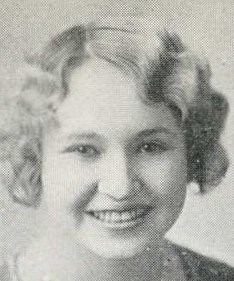 Dorothy Sames. Senior class photograph in Hutchinson High School’s 1929-30 Allagaroo Yearbook. Hutchinson Public Library’s Kansas Room Collection. Also, Mike Ford Collection
Dorothy Sames. Senior class photograph in Hutchinson High School’s 1929-30 Allagaroo Yearbook. Hutchinson Public Library’s Kansas Room Collection. Also, Mike Ford Collection“There’s Clara!” shouted Dorothy, as Uncle Tom slowed and parked the automobile.
“I’m so excited to get an opportunity to see Mattie again!” said Ethel.
As Tom turned off the engine, he added, “I sure hope they have cherry pie with ice cream.”
*
Until next time, happy writing and reading.

The post Sheriffs of Reno County: Tom McGinn appeared first on Sandhenge Publications.
December 2, 2020
Sheriffs of Reno County: Tom Jennings

https://jimpotterauthor.com/wp-content/uploads/2020/11/Sheriffs-of-Reno-County-14-Tom-Jennings.mp3
· Tom Jennings (1860-1916)
Sheriff 1915-1916
·
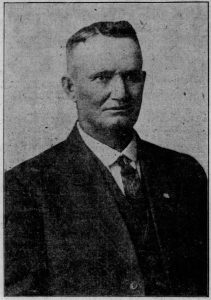 Tom Jennings served two, two year terms (1911-1915) as Under Sheriff for Reno County Sheriff Konrad C. Beck. This photo was used in his successful campaign for sheriff in the summer and fall of 1914. The Hutchinson Gazette, July 19, 1914.
Tom Jennings served two, two year terms (1911-1915) as Under Sheriff for Reno County Sheriff Konrad C. Beck. This photo was used in his successful campaign for sheriff in the summer and fall of 1914. The Hutchinson Gazette, July 19, 1914.It’s Friday, October 21, 1927, in Hutchinson, Kansas. Julia Whiteside and her husband, Houston, are still talking about the opening of the newest J. S. Dillon & Sons store at 13th and Main.
*
“The new Dillon store is clean and modern with reasonable prices,” said Julia.
“John Dillon’s sons, Ray and Clyde, are carrying on their father’s tradition,” said Houston. “Since his early days of repairing wagons and buggies in Sterling, John has always been a successful businessman.
“His business model works,” continued Houston. “Cash and carry, no credit and no home delivery.”
“I hope he’s enjoying his retirement,” said Julia. “Did I tell you I ran into Don Jennings at the store opening last night?”
“No, I didn’t see him. How is he?”
“Don told me he had just received a postcard from Emerson Carey who is traveling in California.”
“He’s known Emerson since he was a boy,” said Houston. “Besides farming, Don’s father, Tom, was the foreman for Emerson’s properties.”
“I know you’ll never forget the phone call we received ten years ago from Emerson in regards to Tom. It was New Year’s eve, almost 1917,” said Julia.
“I remember it like it was yesterday,” said Houston.
“What a loss for all of us, what a tragedy,” said Julia.
*
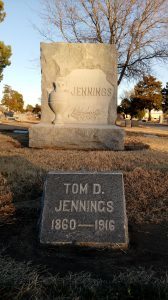 Eastside Cemetery, Hutchinson, Kansas. Photo by Potter
Eastside Cemetery, Hutchinson, Kansas. Photo by PotterHouston Whiteside hung up the phone and turned to Julia. “That was Emerson. Tom Jennings is dead. So is his daughter, Mary. She would have been ten years old in February. Mattie is injured, but alive.”
“What happened?” asked Julia.
“Car accident in the thick fog, on the Trail road between the reformatory and the reformatory barn. Their car ran over the edge of a culvert. They were on their way home from taking supper at John Wallstein’s place.
“Tom thought he heard a car approaching from the rear at a fast rate of speed. He swerved to the side of the road to let the faster car get by. That’s when his Ford went over the edge of the culvert, turning over, and pinning all three of them.
“After a half-hour, they were discovered by occupants of another car who got help from Milt Cross, the superintendent of the Reformatory farm.
“Tom died from being crushed, but he didn’t die immediately. For a while he yelled for help. Mary seemed the least injured, but she gasped her last breath as Mr. Cross carried her to his house. The bodies of Tom and Mary were taken to the Johnson morgue.
“What about Mattie?” asked Julia.
“She was severely bruised and is having breathing problems. She’s at the sheriff’s residence, not a hospital.”
*
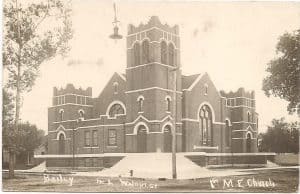 This photo postcard by photographer Marion W. Bailey, shows the Methodist Episcopal Church on the SE corner of 1st Ave. & Walnut St., Hutchinson, KS. The new, red-brick building, was built in 1908. Potter Collection
This photo postcard by photographer Marion W. Bailey, shows the Methodist Episcopal Church on the SE corner of 1st Ave. & Walnut St., Hutchinson, KS. The new, red-brick building, was built in 1908. Potter Collection“Remember how the church was overflowing at the double funeral?” asked Houston.
“It was hot inside,” replied Julia. “Mattie had turned worse. She couldn’t be there.”
“Without Tom and Mary, I wasn’t sure if she wanted to live,” said Houston.
“She tried to rally in order to attend the funeral, but she wasn’t able,” said Julia.
“The Methodist church was packed; there were 1,500 mourners seated, another 500 people standing, and a thousand more outside,” said Houston.
“I’m not sure why, but there were three ministers,” remembered Julia.
“Maybe there were three because one minister wasn’t sufficient to explain why we lost Tom,” said Houston. “He was a man of integrity and a loving family man. Mary, the youngest, was the unexpected child who was considered a gift from god.”
“The Jennings family was so happy,” said Julia. “Tom had won reelection for his second term as sheriff.”
“A landslide win, especially for a Democrat,” said Houston.
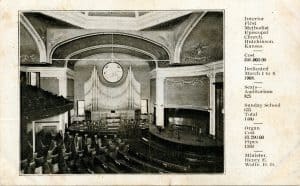 The interior of the First Methodist Episcopal Church, photographed by Charles W. McDaniel, 19 S. Main, Hutchinson, KS. Collection of Morgan Williams, morganw1957@gmail.com
The interior of the First Methodist Episcopal Church, photographed by Charles W. McDaniel, 19 S. Main, Hutchinson, KS. Collection of Morgan Williams, morganw1957@gmail.com“Tom and the family celebrated, but no one in the county should have been surprised about his victory,” said Julia. “He was popular. Tom and Mattie were pleased to have two more years to work for the people of Reno County, and they didn’t need to move their family back home from the sheriff’s residence.”
“The pall bearers for Tom’s coffin were all Kansas sheriffs from surrounding counties,” said Houston. “The Odd Fellows Lodge kept everything orderly.
“Members of the Bar Association, the court house officials, the police force of the city, and the members of Junior Musical Club, to which the little daughter belonged, were all in attendance.”
“There was hardly a dry eye as the two caskets were carried down the aisle of the church with the father and daughter asleep in death,” said Julia.
*
“The petition to ask Governor Capper to appoint Don Jennings as the new sheriff was picking up steam at the time of the funeral,” said Houston. “Don was young but a competent deputy.”
“People got upset,” said Julia. “They were more annoyed with William Morgan than they were with the governor. People hoped that even though Morgan was the Republican lieutenant governor, that he would support the wishes of county voters and use his influence with the governor.”
“I know the Democratic papers accused our lieutenant governor of not using his position when it was needed by the voters who elected him,” continued Houston, “but there wasn’t any chance that Capper would select Don Jennings, a Democrat, to fill his father’s spot for sheriff.
 Reno County Sheriff’s Under Sheriff Tom McGinn. Frank Niemeir Collection
Reno County Sheriff’s Under Sheriff Tom McGinn. Frank Niemeir Collection“What about Tom McGinn?” asked Julia. “He was the one with six years of experience as under sheriff. Why wasn’t he chosen to succeed Jennings?”
“The petitions were asking for Tom’s son, Don, to fill the sheriff’s spot,” answered Houston, “because it was a sympathy vote, sort of a widow’s succession. In some states and jurisdictions, a male politician who died in office was directly succeeded by his widow, either through election or direct appointment to the seat.”
“I understand the idea was to provide Mrs. Jennings with financial support due to the loss of her family’s primary income,” said Julia.
“Or, sometimes, to avoid the risk of a protracted fight for the nomination between elections,” added Houston. “But this was different, a new sheriff was going to be sworn in after Tom’s death, and the governor was not obligated to choose a person of the same party as the winner of the fall election.
“Especially at the state level, Republicans take care of Republicans, Democrats take care of Democrats. Remember, Reno County voters elected Tom Jennings over Scott Sprout; they didn’t choose Don Jennings for any office. He was merely a deputy sheriff serving at the pleasure of his father.”
“I understand,” concluded Julia, “when the governor appointed Scott Sprout as sheriff, it wasn’t about experience or sympathy, it was about politics.”
*
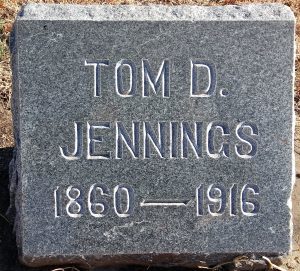 Eastside Cemetery, Hutchinson, KS
Eastside Cemetery, Hutchinson, KS 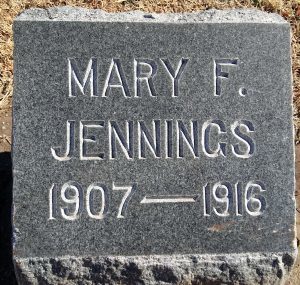 Eastside Cemetery
Eastside CemeteryReverend J. W. Able of the First Methodist Church was the final speaker at the funeral services of Sheriff Tom Jennings and his daughter, Mary.
“Sheriff Jennings was a stalwart citizen, courageous in the face of danger or wherever danger called. Here we have evidence of the immortality of the soul. Man is too big for this life. Sheriff Jennings’ plans were not consummated in the dark of night when his spirit took its flight. And the life plans for little Mary were not finished.
Reverend Able concluded, “There is no death. What seems so is a transition of the soul.”
*
“Julia,” said Houston, “Tom Jennings was the first Reno County sheriff to die in office. I just hope he’s the last.”
*
Until next time, happy writing and reading.

The post Sheriffs of Reno County: Tom Jennings appeared first on Sandhenge Publications.



